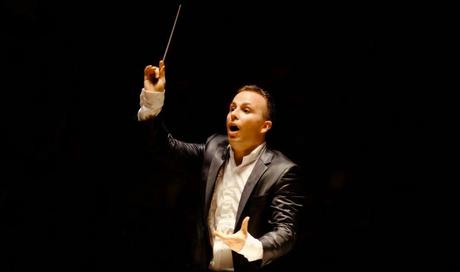by Paul J. Pelkonen

Yannick Nézet-Séguin.
Photo by Marco Borggreve from the conductor's official site.
Mounting the Resurrection at Carnegie Hall is not without its challenges. The gigantic orchestra and chorus (here, the Westminster Symphonic Choir) pack like commuters onto the stage, with a lone stage-left bassist forced outside the proscenium arch. The Hall lacks a pipe organ (required for the last movement) but most ensembles make do with its electronic equivalent. Finally, there's that sense of history and the maestros past who have done battle with this five-headed dragon of a symphony, a demanding conflation of Romanticism and apocalyptic Christian imagery that ranks among Mahler's most popular works.
At the start of the first movement, Mr. Nézet-Séguin waited for silence before giving the downbeat for Mahler's most famous funeral march, opening with a string tremolo and a shuffling, chugging rhythm in the double bass. Mr. Nézet-Séguin conducted this movement in an expansive manner, letting big climaxes make their own statement and counting on his soloists to draw important phrases out. Indeed, the whole work had a cohesive feel, as these small musical ideas (a Dies irae figure and the repeated tolling of bell-like intervals) would pay off in the finale.
The pastoral second movement lacked momentum, with the orchestra too subdued in passages where the music needed to lilt and lift. The third movement was better, a winding, snaky scherzo with minor-key cries of despair in the woodwinds and muttered Viennese waltzes played by the low strings. It culminated in a "cry of terror" (Mahler's own description), a bitonal clash of keys evoking horror and despair.
The fourth started without pause, with mezzo-soprano Sarah Connolly's quiet entrance all the more powerful for its lack of drama. This movement, a setting of the song Urlicht ("Primeval Light") from the collection Des Knaben Wunderhorn, serves as comfort after the terror: a real human voice commenting on these apocalyptic events. Mr. Nézet-Séguin lingered over the phrases here, clearly in his element in supporting Ms. Connolly, whose round, warm tones comforted and promised a better world to come.
Mahler opens the giant finale of this symphony with a nod to Beethoven, the return of the third movement's "cry of terror" as a bitonal clash of keys blasted forth by the whole orchestra. This struck like a closed fist before yielding toan ascending figure in the horns which sounds remarkably like the chorale from Wagner's "Wacht auf" in Act III of Meistersinger. This chorale is the eventual destination of this huge movement, the symphony's ultimate musical and spiritual goal. The finale goes on to depict the rising of the dead from their graves, the march to judgment, and terror giving way to relief and ultimately, salvation.
Mr. Nézet-Séguin's leisurely, detailed approach to the middle movements paid dividends here, taking care and detail in the depiction of Mahler's end-of-the-world scenario, leading the vast army of onstage musicians (and the smaller squad of brass players offstage to the right in a stirring performance that moved inexorably to the entry of the singers and chorus. Soprano Angela Meade (in her first major German-language appearance on the Carnegie stage) sang the opening lines of the Klopstock text with authority and passion, hinting at bigger things in the future of this bel canto specialist.
If the first part of the movement paid dividends, the close of the symphony, with the added shout of the choral singers hit the proverbial jackpot. Mr. Nézet-Séguin seemed to elevate the performance into its final key shift, willing the orchestra and chorus to dizzying heights as the sound flooded the auditorium. If the other Mahler symphonies are in the future of this conductor's Philadelphia term, then that future is a promising one.

